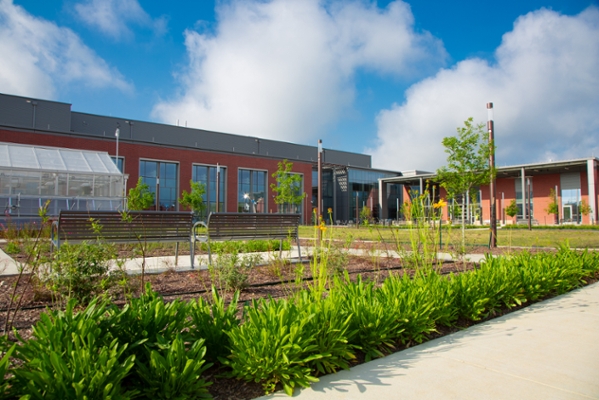LU Celebrates Grand Opening of Science and Technology Building
The grand opening of Lamar University’s highly anticipated Science and Technology Building is April 3 at 1 p.m. in the north courtyard of the building. The new building is located on the south end of the campus between the Speech and Hearing Building and Monroe Hall.
Construction of the 83,000-square foot building began May 2, 2017, at which time, Texas State University  System (TSUS) Regent, Bill Scott, said a new academic building on the LU campus “is long overdue.” It is the first entirely academic building to be constructed on campus in more than forty years.
System (TSUS) Regent, Bill Scott, said a new academic building on the LU campus “is long overdue.” It is the first entirely academic building to be constructed on campus in more than forty years.
Lamar University President Kenneth Evans said the new building will primarily be used for research. “Lamar University is a diverse research institution,” said Evans. “It’s the university’s mission to provide guidance and support to the university community for research and that’s the purpose of this building.”
The building has seven instructional labs, 14 research labs and a large project instruction room upstairs that overlooks a greenhouse.
Dr. Ashwini Kucknoor, a Lamar University associate professor of biology and a member of the building’s planning committee, called the building is an investment in the next generation of researchers.
“If universities like Lamar University are to continue to conduct the vital research that transforms our world and enhances our lives, then faculty and students must have the facilities and the space to support learning and research,” said Kucknoor. “The Science and Technology Building is a facility that has been designed to foster collaboration. Shared research and lab space will provide us opportunities to work together on cutting-edge projects. Collaboration is at the heart of discovery.”
In addition to housing classrooms for students, the new building will house collaborative university research projects selected based on a competitive application process. (Initial research projects have been announced. See research projects.)
”The building transforms the educational enterprise by providing students and faculty the opportunity to work in interdisciplinary teams to meet real world challenges. First semester students will work in teams of science, business, arts, humanities and engineering to resolve a challenge presented by industry leaders,” said Vice President for University Advancement and CEO, Lamar University Foundation Juan Zabala. “These problems can range from medical to transportation needs, communication challenges to environmental issues. Under the guidance and tutelage of faculty teams, the students will develop, test and prototype ideas and develop marketing and business plans.”
The building will house a “maker space,” designed similarly to Rice University’s “design kitchen.” Evans said the maker space is his favorite. ““The maker space is where students can fabricate ideas they develop into product prototypes,” said Evans. “This space is intended to give students a real-world, hands-on, practical experience while creating.”
Both students and faculty will come together in the maker’s space to fabricate items using 3D printers and drill presses, which can then be used to further research and innovation
Finally, the Science and Technology Building has several student-focused spaces – a lounge, several breakout rooms and a self-serve, micro-market. It also is home to multiple additions of Lamar University’s growing collection of public art.
“The new space brings to the educational programs the ability to teach theory and concepts to students across the campus, and to bring them into the labs to test their understanding of those principles,” said Zabala.
Overall, the building adds to the beautification of Lamar University’s campus while remaining both practical and functional and is the fourth building to be reconstructed or renovated since the arrival of President Evans to the university in 2013.


